Redefining species limits in the Fusarium fujikuroi species complex
- PMID: 35935895
- PMCID: PMC9311392
- DOI: 10.3767/persoonia.2021.46.05
Redefining species limits in the Fusarium fujikuroi species complex
Abstract
The Fusarium fujikuroi species complex (FFSC) includes more than 60 phylogenetic species (phylospecies) with both phytopathological and clinical importance. Because of their economical relevance, a stable taxonomy and nomenclature is crucial for species in the FFSC. To attain this goal, we examined type specimens and representative cultures of several species by employing morphology and phylogenetic analyses based on partial gene fragments of the translation elongation factor 1-alpha (tef1), beta-tubulin (tub2), calmodulin (cmdA), RNA polymerase largest subunit (rpb1) and RNA polymerase II second largest subunit (rpb2). Based on these results three new species were delimited in the FFSC. Two of these phylospecies clustered within the African clade, and one in the American clade. Epitypes were also designated for six previously described FFSC species including F. proliferatum and F. verticillioides, and a neotype designated for F. subglutinans. Furthermore, both F. acutatum and F. ophioides, which were previously invalidly published, are validated. Citation: Yilmaz N, Sandoval-Denis M, Lombard L, et al. 2021. Redefining species limits in the Fusarium fujikuroi species complex. Persoonia 46: 129-162. https://doi.org/10.3767/persoonia.2021.46.05.
Keywords: epitypification; fungal taxonomy; morphology; neotypification; new taxa; validation.
© 2021 Naturalis Biodiversity Center & Westerdijk Fungal Biodiversity Institute.
Figures
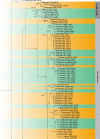




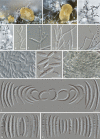
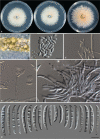

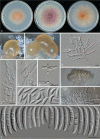
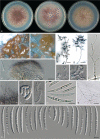
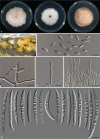

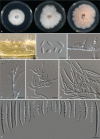
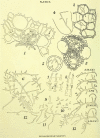
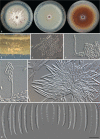
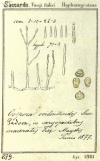
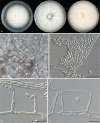
Similar articles
-
Morphological and phylogenetic analyses reveal two new species of the Fusariumfujikuroi (Hypocreales, Nectriaceae) species complex in China.MycoKeys. 2025 Jan 16;112:127-163. doi: 10.3897/mycokeys.112.133472. eCollection 2025. MycoKeys. 2025. PMID: 39867689 Free PMC article.
-
Fusarium and allied genera from China: species diversity and distribution.Persoonia. 2022 Jul 12;48:1-53. doi: 10.3767/persoonia.2023.48.01. Epub 2022 Feb 21. Persoonia. 2022. PMID: 38234691 Free PMC article.
-
Species composition of and fumonisin production by the Fusarium fujikuroi species complex isolated from Korean cereals.Int J Food Microbiol. 2018 Feb 21;267:62-69. doi: 10.1016/j.ijfoodmicro.2017.12.006. Epub 2017 Dec 13. Int J Food Microbiol. 2018. PMID: 29291460
-
Fusarium volatile, a new potential pathogen from a human respiratory sample.Fungal Syst Evol. 2019 Dec;4:171-181. doi: 10.3114/fuse.2019.04.09. Epub 2019 Jun 25. Fungal Syst Evol. 2019. PMID: 32467910 Free PMC article.
-
Known from trees and the tropics: new insights into the Fusarium lateritium species complex.Stud Mycol. 2024 Dec;109:403-450. doi: 10.3114/sim.2024.109.06. Epub 2024 Sep 26. Stud Mycol. 2024. PMID: 39717659 Free PMC article.
Cited by
-
Comprehensive Investigation of Die-Back Disease Caused by Fusarium in Durian.Plants (Basel). 2023 Aug 24;12(17):3045. doi: 10.3390/plants12173045. Plants (Basel). 2023. PMID: 37687292 Free PMC article.
-
Fusarium diversity from the Golden Gate Highlands National Park.Front Microbiol. 2023 Apr 13;14:1149853. doi: 10.3389/fmicb.2023.1149853. eCollection 2023. Front Microbiol. 2023. PMID: 37125158 Free PMC article.
-
In vitro activity of novel antifungals, natamycin, and terbinafine against Fusarium.Antimicrob Agents Chemother. 2025 Jun 4;69(6):e0191324. doi: 10.1128/aac.01913-24. Epub 2025 May 15. Antimicrob Agents Chemother. 2025. PMID: 40372083 Free PMC article.
-
Identification and Pathogenicity of Fusarium Species Associated with Onion Basal Rot in the Moscow Region of Russian Federation.J Fungi (Basel). 2024 May 4;10(5):331. doi: 10.3390/jof10050331. J Fungi (Basel). 2024. PMID: 38786686 Free PMC article.
-
Molecular identification of Fusarium species in commercial vanilla and crop wild relatives in Colombia.Environ Microbiol Rep. 2024 Dec;16(6):e70038. doi: 10.1111/1758-2229.70038. Environ Microbiol Rep. 2024. PMID: 39529386 Free PMC article.
References
-
- Akaike H. 1974. A new look at the statistical model identification. IEEE Transations on Automatic Control 19: 716–723.
-
- Al-Hatmi AMS, Mirabolfathy M, Hagen F, et al. . 2016b. DNA barcoding, MALDI-TOF, and AFLP data support Fusarium ficicrescens as a distinct species within the Fusarium fujikuroi species complex. Fungal Biology 120: 265–278. - PubMed
-
- Aoki T, O’Donnell K, Geiser DM. 2014. Systematics of key phytopathogenic Fusarium species: current status and future challenges. Journal of General Plant Pathology 80: 189–201.
LinkOut - more resources
Full Text Sources
